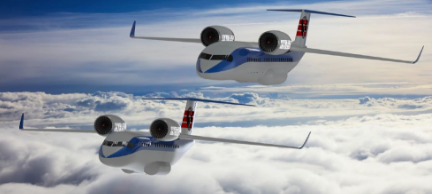KU aerospace engineering claims top honors in international competitions
LAWRENCE — Aerospace engineering students at the University of Kansas have once again brought home multiple awards in international design competition, continuing a 40-year tradition of excellence.
 Three KU teams were recognized for their aircraft and missile designs by the American Institute of Aeronautics and Astronautics (AIAA). Additionally, a team from KU won an award for the university’s first-ever entry in the Vertical Flight Society’s international student competition.
Three KU teams were recognized for their aircraft and missile designs by the American Institute of Aeronautics and Astronautics (AIAA). Additionally, a team from KU won an award for the university’s first-ever entry in the Vertical Flight Society’s international student competition.
"The AIAA sponsors the world's premier aircraft design competition,” said Ron Barrett-Gonzalez, professor of aerospace engineering. And KU is at the pinnacle of that competition. Over the last four decades, KU students have won more first-, second- and third-place aerospace design awards in the AIAA competition than any other university in the world.
In addition to that overall success, Barrett-Gonzalez said that since 2010, 24 women and underrepresented minorities have been among the university’s winning individuals and teams.
“In many, many ways, diversity powers our teams, which is really great,” Barrett-Gonzalez said.
The design competitions challenge students to participate in a simulated real-world design process, allowing them to gain experience and receive feedback from technical experts who serve as judges. The KU student teams won the following awards:
AIAA Graduate Team Aircraft Design, first place
The 10-person team designed the “Skyblazer,” a regional jet intended to be more profitable and more environmentally friendly than most current 50-seat models. The KU students designed an aircraft with wings and engines across the top of the fuselage — instead of the traditional below-the-fuselage models — making it possible to load and unload luggage more quickly, which in turn would increase the potential number of flights per day for the aircraft. Team members were Matthew Griebe, Lendon Jackson, Skyler Jacob, Bhawantha Nilaweera, Raghav Parikh, Renaldo Rivera, Olivia Scharf, Ethan Seiler, Krishna Sitaula and Brennan Wheatley.
Jackson — who led the team, graduated in May and now works at Boeing — said he benefited at KU from his participation in the National Society of Black Engineers, the IHAWKe diversity program and as a member of Alpha Phi Alpha fraternity, a historically Black fraternity. “The reason why I decided to go to KU was because when I visited, I felt welcomed,” he said.
“I just hope that I inspire others to take on the challenge,” Jackson said. “It could be intimidating. But if it's something that you are passionate about or even interested in. I definitely challenge those others that are interested in it to go for it, especially at KU.”
AIAA Graduate Team Missile Design, second place
The six-person team was recognized for its “RHI*NO” drone, a small reusable unmanned aircraft designed to hunt down and disable enemy drones using nets fired from shotgun shells. Team members were Jack Barkei, Bobby Bowes, Christopher Eavenson, Samantha Friess, Brian Von Holtz and Alex Welicky.
AIAA Graduate Team Missile Design, third place
The three-person team also designed an ultra-small drone to hunt down enemy drones. The “Valkyrie” was designed to be fired from a hand-held grenade launcher before unfolding its wings and starting its mission. Team members were Joe Coldiron, Austin Dooley and Nathan Wolf.
Wolf, now a graduate student, said the design process solidified his decision to continue his education in aerospace engineering and to pursue design as his emphasis because it brings together all the various aspects of building an aircraft. “This is what I want to do, because you get to have a hand in everything,” he said. “You get to do the first step analysis on the stability, you do the aerodynamics, the propulsion, everything. And that was really cool.”
Vertical Flight Society, Best New Undergraduate Entrant
KU was recognized for its “Asklepios” drone. It was designed to take off vertically, then tilt and fly laterally like a traditional aircraft to deliver medical equipment to hospitals and emergency locations. Team members were Micaela Crispin, Mason Denneler and Zack Schwab.
Denneler, now a graduate student, said it was exciting to win the VFS honor and break new ground for KU’s already storied aerospace program. “KU is not known as a helicopter school, but we made it work,” he said. “I think that this is the kind of thing that you'll see more of in the future. Not necessarily this design explicitly, but you'll see a lot of delivery drones and people movers. I think in 10 to 15 years there's going to be a lot more of these innovative ways to move people and things.”
Barrett-Gonzalez said one reason for KU’s success in student aircraft design competitions is that the teams bring in help from other departments across the university and alumni.
“We regularly work with students and faculty members in paleontology, history, visual art, business, law, architecture and design,” he said. “Our aircraft perform as well as those coming from ‘tech’ schools like CalTech, MIT and Purdue; however, our business plans are very solid, the aircraft cost less to operate, have lower carbon footprints, are safe, certifiable and frankly look a lot better. Additionally, our alumni mentor and advise the teams, keeping them up on the latest technologies and trends. In short, we harness the power of KU."
With nearly 30,000 individual members from 91 countries, and 95 corporate members, AIAA is the world’s largest technical society dedicated to the global aerospace profession. The Vertical Flight Society is the world’s premier vertical flight technical society, providing leadership for scientific, technical, educational and legislative initiatives that advance the state of the art of vertical flight.
Photo: Winning "Skyblazer" design from KU Engineering. Credit: KU Engineering.